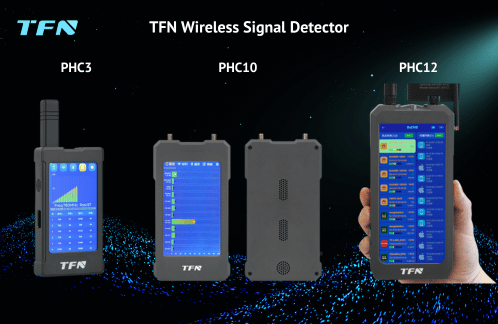Differences between TFN PHC3, PHC10 and PHC12 wireless signal detection devices
With the rapid development of wireless communication technology, wireless signal detection devices have become an important means to maintain information security and combat illegal eavesdropping and tracking. As three representative wireless signal detection devices, TFN's PHC3, PHC10 and PHC12 each show different advantages in functions, performance, technical characteristics and application scenarios. This article will explore the main differences between the three devices in depth from these aspects.

1. Functional Differences
PHC3: Basic and diverse detection capabilities
As a basic and versatile wireless signal detection device, PHC3 is characterized by supporting a variety of wireless communication standards and protocols with global coverage, including 2G/3G/4G/5G signals, 2.4G&5GHz Wi-Fi and Bluetooth. This enables PHC3 to cope with a variety of complex wireless environments and effectively detect and identify various types of wireless eavesdropping, peeping and tracking devices. Its compact and portable design allows users to quickly deploy it in various occasions, while its high sensitivity and accuracy ensure the reliability of detection. In addition, PHC3 also has a separate 2.4GHz band detector that can accurately identify and find Wi-Fi 2.4G hotspots and terminal devices, as well as Bluetooth terminal devices such as AirTag, Huawei Tag, etc.
PHC10: Enhanced positioning function
Compared with PHC3, PHC10 has been significantly enhanced in terms of functionality. In addition to maintaining support for wireless communication formats with global coverage, PHC10 also adds the positioning function for wireless signals of specified frequencies. This function allows users to more accurately lock the location of wireless eavesdroppers and trackers, thereby more effectively preventing and combating them. At the same time, PHC10 uses a 5-inch color TFT capacitive touch display, providing a more intuitive and convenient operating experience.
PHC12: Innovative technology and further upgrades
PHC12 is the more powerful and diverse of the three devices. It not only has the advantages of PHC3 and PHC10, but also has been upgraded and innovated on this basis. PHC12 integrates infrared thermal imaging function, which can sensitively detect heat distribution, complementing signal detection to provide users with more intuitive and detailed detection results. In addition, PHC12 also supports detailed distinction of Wi-Fi 2.4G/5.8G protocols, including hotspots, connected devices, unconnected devices, and camera devices, effectively locating and troubleshooting potential safety hazards. In terms of Bluetooth device detection, PHC12 can distinguish the type, name and manufacturer of Bluetooth devices, and supports accurate tracking and positioning of specified Bluetooth signals. At the same time, PHC12 also supports demodulation and restoration of sound playback of specified suspected FM/AM signals, further enhancing its application scope and practicality.
2. Performance Comparison
2.1 Detection frequency range
PHC12 has a greater advantage in the detection frequency range. Its frequency range reaches 0-12GHz, covering many important wireless communication frequency bands currently used internationally and domestically. The detection frequency range of PHC3 and PHC10 is 1MHz to 6GHz, which is wide enough, but may be slightly insufficient in certain specific frequency bands. This difference makes PHC12 more advantageous in dealing with complex wireless environments.
2.2 Sensitivity and accuracy
All three devices perform well in sensitivity and accuracy, but PHC12 has stronger detection capabilities in complex environments by supporting sensitivity adjustment and more detection frequency bands. At the same time, PHC12 also supports accurate tracking and positioning of specified signals, further improving the precision of detection.
2.3 Battery life
In terms of battery life, PHC12 can work for up to 2-3 hours, which is longer than the 2 hours of full charge of PHC3 and PHC10, so PHC12 can provide more lasting support.
2.4 Display and operation
In terms of display and operation, the 6.67-inch color touch screen of PHC12 not only provides a larger display space, but also makes the operation more intuitive and convenient. The 5-inch color TFT capacitive touch display of PHC10 is also larger than the 4.3-inch display of PHC3. In addition, PHC12 also supports external multi-type antennas, which can enhance the accurate detection and analysis of specified signals, further improving its flexibility and practicality.
3. Application Scenarios
All three devices are suitable for scenarios with wireless environment security risks, such as military industry, government, banking and finance, business hotels, and private residences. However, due to their differences in functions and performance, the specific application scenarios will also be different. PHC3 is small and portable and highly sensitive, suitable for quick inspections and temporary inspections; PHC10 is more suitable for long-term monitoring and detailed analysis due to its positioning and logging functions; and PHC12 performs well in high-precision positioning and detection in complex environments with its diverse detection functions and infrared thermal imaging technology.
PHC3, PHC10, and PHC12 are three wireless signal detection devices with their own characteristics, and they differ in functions, performance, and application scenarios. When choosing, users can make comprehensive considerations based on their own needs and scene characteristics to choose a wireless signal detection device that suits them.
If you are interested in TFN PHC3, PHC10 and PHC12 wireless signal detection devices, please contact TFN sales team:
Email: info@tfngj.com
WhatsApp: +86-18765219251
Facebook: https://www.facebook.com/tfnfate/
